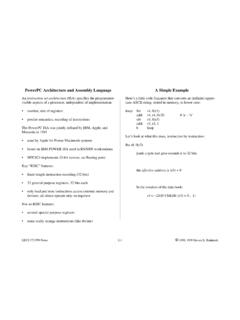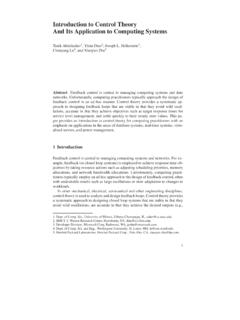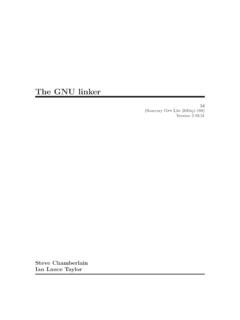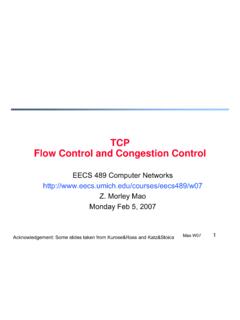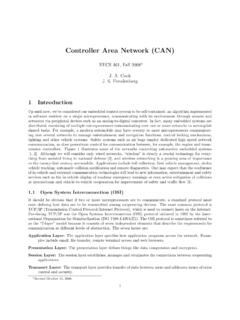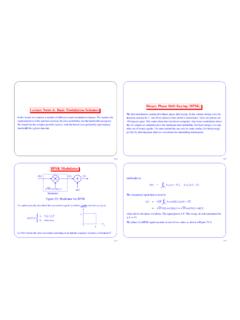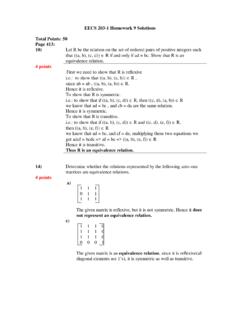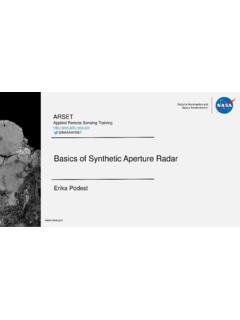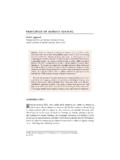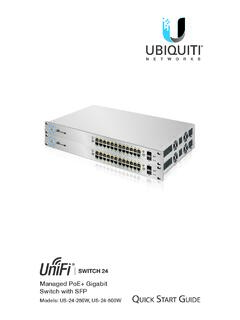Transcription of Course Notes 1: Introduction to Biomedical Instrumentation ...
1 Course Notes 1: Introduction to Biomedical Instrumentation 1 Section Objectives Understand the canonical structure of Biomedical Instrumentation systems. Learn the qualitative functions of the four primary system components (sensors, actuators, electronics interface, computation unit). Learn the technical vocabulary associated with Instrumentation and design and basic signal analysis (italicized words and phrases). Learn / review the static and dynamic performance characteristics for Instrumentation systems. 2 Introduction to Biomedical Instruments Biomedical instruments refer to a very broad class of devices and systems.
2 A Biomedical instrument is an ECG machine to many people. To others, it's a chemical biosensor, and to some it's a medical imaging system. Current estimates place the worldwide market for Biomedical instruments at over $200. billion. Biomedical instruments are ubiquitous; they are significant to the broader technology and biotechnology sectors; and, finally, they are vital to many medical and scientific fields. Bottom line: This Course is worthwhile!! Even though there is a wide variety of instruments, almost all of them can be modeled using the simple diagram below. Basic model of Instrumentation systems.
3 BiomedE/EECS 458: Biomedical Instrumentation and Design Winter, 2002. D. Kipke (revised from M. O'Donnell). Section 1: 2. All Biomedical instruments must interface with biological materials (by definition). The interface can by direct contact or by indirect contact ( , induced fields). In this Course we will primarily study sensing systems, which means that the system front-end will generally be a sensing element. Other than this restriction, we will cover all aspects of typical Biomedical Instrumentation systems. We will do them in the following order: 1. Basic Sensors and Principles -- including biopotential electrodes 2.
4 Electronic Interfacing: including system noise figure, system bandwidth, pre-amplifiers, post- amps, Instrumentation amps, A/D and D/A converters, aliasing, triggering and signal averaging 3. Computation: including data capture and signal processing 4. Systems: complete system response using specific examples (electromyogram, pressure sensors and blood pressure measurements, flow sensors and blood flow measurements, and chemical biosensors). Sensors and Actuators A sensor must: detect biochemical, bioelectrical, or biophysical parameters reproduce the physiologic time response of these parameters provide a safe interface with biological materials An actuator must: deliver external agents via direct or indirect contact control biochemical, bioelectrical, or biophysical parameters provide a safe interface with biologic materials Electronics Interface The electronics interface must.
5 Match the electrical characteristics of the sensor/actuator with the computation unit preserve signal-to-noise ratio (SNR) of sensor preserve efficiency of actuator preserve bandwidth ( , time response) of sensor/actuator provide a safe interface with the sensor/actuator provide a safe interface with the computation unit provide secondary signal processing functions for the system Computation Unit The computation unit must: provide primary user interface provide primary control for the overall system BiomedE/EECS 458: Biomedical Instrumentation and Design Winter, 2002. D. Kipke (revised from M.)
6 O'Donnell). Section 1: 3. provide data storage for the system provide primary signal processing functions for the system maintain safe operation of the overall system Types of Biomedical Instrumentation Systems Types of Biomedical Instrumentation Systems Direct I Indirect Invasive I Noninvasive Contact I Remote Sense I Actuate Dynamic I Static Direct/Indirect: The sensing system measure a physiologic parameter directly, such as the average volume blood flow in an artery, or measures a parameter related to the physiologic parameter of interest ( , ECG recording at the body surface is related to propagation of the action potential in the heart but is not a measurement of the propagation waveform).
7 Invasive/Noninvasive: Direct electrical recording of the action potential in nerve fibers using an implantable electrode system is an example of an invasive sensor. An imaging system measuring blood flow dynamics in an artery ( , ultrasound color flow imaging of the carotid artery) is an example of a non-invasive sensor. Contact/Remote: A strain gauge sensor attached to a muscle fiber can record deformations and forces in the muscle. An MRI or ultrasound imaging system can measure internal deformations and forces without contacting the tissue. Sense/Actuate: A sensor detects biochemical, bioelectrical, or biophysical parameters.
8 An actuator delivers external agents via direct or indirect contact and/or controls biochemical, bioelectrical, or biophysical parameters. An automated insulin delivery pump is an example of a direct, contact actuator. Noninvasive surgery with high intensity, focused ultrasound (HIFU) is an example of a remote, noninvasive actuator. Dynamic/Static: Static instruments measure temporal averages of physiologic parameters. Real-time instruments have a time response faster than or equal to the physiologic time constants of the sensed parameter. For example a real-time, ultrasound Doppler system can measure changes in arterial blood velocity over a cardiac cycle.
9 Passive Instruments, Active Instruments, and Balancing Instruments. Medical Measurement Parameters !!!Add scanned image of Webster table here . Characteristics of Signals A signal is any physical quantity that varies with time (or other independent variable) and carries information. Signals can be classified as either continuous or discrete. A continuous signal changes BiomedE/EECS 458: Biomedical Instrumentation and Design Winter, 2002. D. Kipke (revised from M. O'Donnell). Section 1: 4. smoothly, without interruption. A discrete signal changes in definite steps, or in a quantized manner. The terms continuous and discrete can be applied either to the value (amplitude) or to the time characteristics of a signal.
10 In nature (including biology), most signals are analog, , they take on continuous values (amplitude and time) within a particular range. Continuous-time signals exist continually at all times (during a specified time period). Discrete-time signals are defined only at selected instances of time. Sampling is the process to convert continuous-time signals to discrete-time signals. Quantizing is the process that converts continuous (in amplitude) discrete-time signals to digital signals. Signals in which time is the independent variable are referred to as time-domain signals. Likewise, when frequency is the independent variable, the signals are referred to as frequency-domain signals.
